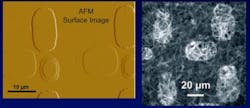Nanoworms with shining quantum dots for a new dimension in microscopy
In the 1990s single molecules “walking” over clean surfaces were discovered and created a lot of excitement among scientists. Research evolved for two decades and now we have complete microtubules with nano-sized motors carrying shining quantum dots across samples. Although their diameter of 25 nm is too small for conventional microscopes you may see them crawling around due to their fluorescent quantum lanterns.
At the recent 118th Annual Meeting of the German Society of Applied Optics DGaO in Dresden, Germany, Stefan Diez from the Dresden based B CUBE – Center for Molecular Bioengineering presented two decades of progress and recent findings on biomolecular transport systems for optical imaging.
Matching nanotechnology, microbiology, and photonics
What may sound like a fascinating invention of a sci-fi author is actually the result of cutting edge research. And as so often it requires the close cooperation of several different experts.
It all starts with biology: For many processes in our cells we rely on diffusion processes. But if that turns out to be too slow, we have molecular machines that perform complex mechanical tasks such as intracellular transport, chromosome separation, and muscle contraction.
One example is Kinesin-motors. These proteins convert chemical energy, in the form of the high-energy phosphate bond of ATP, into directed motion. When put in contact with cytoskeletal filaments, such as microtubules, the latter can act as “nanoworms”, capable of transporting a variety of other molecules. For instance, quantum dots as cargo can be excited for fluorescence and serve as lanterns on these nanoworms. Alternatively, you may attach green fluorescent proteins GFP, the workhorses of fluorescence microscopy.
Seeing them
To understand the physics of the movement, the scientists attached quantum dots to a number of motor molecules. Supported by simulation calculations they could distinguish between straight and spiraling movements. Typical step sizes were on the order of 4 to 16 nm.
While the initial observations of moving molecules were done by tunneling electron microscopy, the microtubules could be equipped with motor molecules and fluorescent molecules that made them accessible by optical fluorescence microscopy.
The kinesin-driven nanoworms used by Diez and his colleagues have a typical diameter of 25 nm and move with a speed of approximately 1 µm per second. The scientists watched them moving on clean surfaces, and later they applied more structured substrates with gaps or roadblocks. Using fluorescence interference contrast (FLIC) microscopy, they could even see their 3D movements and measure the heights of the structures with nanometer resolution.
Applications
In fact, biomolecular transport systems are being investigated by many groups worldwide. Applications in microscopy are obvious: The nanoworms can explore surfaces and see not only topological structures but also other physical effects such as optical near-field phenomena. Those investigations are in an advanced state and will add a dynamic new dimension to the fast-growing field of super-resolution microscopy.
It takes a bit more phantasy to understand their application for supercomputing. Similar to quantum or DNA computers, the nanotubules can perform analog calculations while moving on specially prepared surfaces. The team in Dresden made a detailed proposal on how to use microtubules for dynamic programming algorithms to solve the Subset Sum Problem.
Finally, there are plenty of nanotechnology applications envisioned. Nanofabrication and molecular sorting are just two possibilities—molecular robots are the more advanced vision. After all, kinesin motors are highly efficient (>50% energy conversion), inexpensive, and easy to produce.
References
“Quantum-dot-assisted characterization of microtubule rotations during cargo transport” B. Nitzsche, F. Ruhnow, S. Diez, Nat. Nanotechnol 3(9), 552-556 (2008).
http://www.nature.com/nnano/journal/v3/n9/full/nnano.2008.216.html
“3D nanometer tracking of motile microtubules on reflective surfaces” J. W. J. Kerssemakers, L. Ionov, U. Queitsch, S. Luna, H. Hess, S. Diez, Small, 5(15) 1732-1737 (2009).
http://onlinelibrary.wiley.com/doi/10.1002/smll.200801388/abstract
About the Author
Andreas Thoss
Contributing Editor, Germany
Andreas Thoss is the Managing Director of THOSS Media (Berlin) and has many years of experience in photonics-related research, publishing, marketing, and public relations. He worked with John Wiley & Sons until 2010, when he founded THOSS Media. In 2012, he founded the scientific journal Advanced Optical Technologies. His university research focused on ultrashort and ultra-intense laser pulses, and he holds several patents.



